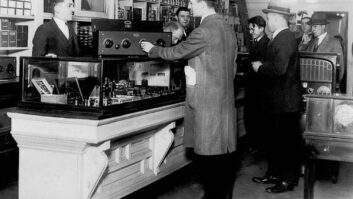When discussing microphones for broadcast and voiceover use, a few familiar brands tend to bubble to the surface. Shure, Electro-Voice, Sennheiser and Neumann routinely are spoken in the same breath.
Product CapsuleTHUMBS UP
Optimized for voiceover and announcer use
Solid and weighty
Internal FET circuitry immune to tube frailties
THUMBS DOWN
More plosive protection needed
Might be priced high for a broadcast studio mic
Price: $900
For information, contact Lawson Inc. in Nashville at (615) 269-5542 or visit www.lawsonmicrophones.com.
To a lesser extent, but by no means lesser performers, are Røde, Blue, Crown, CAD, Countryman and numerous others. As of late, inexpensive condenser units have come forth from Behringer, Samson, Marshall, Carvin and other manufacturers, with varying degrees of performance for the price.
The name Lawson pops up frequently in the music recording community, but not so in the radio or narration end of the business. With a design and manufacturing facility based in Nashville, this small company has been cranking out high-quality capsule mics for vocalists and musical instruments for a few years. One model even earned an award from Radio World’s sister publication Pro Audio Review.
While it’s not a prominent brand name in the voiceover microphone market right now, the introduction of the Lawson AIR microphone might move awareness of the company up a few notches.
Almost ready to hatch
The new AIR is in the final throes of beta testing, so while it is not yet available, here is an early glimpse, courtesy of Mr. Gene Lawson himself and RW.
First, the construction of the AIR mic. The beta model has a nickel-plated brass pop screen and a turned aluminum body, about the size of the company’s L47SH microphone but minus the gold trim and blue finish found on that model. I have been told this is not the official release design, as construction and body have not yet been finalized.
As is, its stubby temporary body and tall capsule cage gives it a look reminiscent of old “air raid” sirens of the 1950s, seen in movies and atop City Halls everywhere.
The capsule is protected by double screening – a large mesh screen sits atop a tighter screen with smaller spaces. Pop immunity is satisfactory on all but the closest of reads.
Thanks to its brass and aluminum body, the AIR mic has the heft of a mallet. Good thing, too, as users in the on-air studio likely will subject it to more abuse than it would receive in a music space. Radio broadcast mics suspended from booms are swung around mercilessly by air talent more preoccupied with their performance than with how delicate a microphone might be.
The robustness of this mic is bolstered further by the use of field-effect transistor circuitry rather than a vacuum tube. As a broadcast concession, this makes sense.
An oft-repeated mantra in these pages has been that broadcasters have been trying to eliminate tubes for 40 years. High-energy broadcasters cannot concern themselves with blown filaments, distortion or anything else that would inhibit performance and perhaps take a microphone out of service.
It should be noted this is still a fragile condenser capsule microphone and a large degree of care must be practiced. This mic cannot be used to pound nails, as can an E-V 635.
Something else on-air talent might not be used to: This is a side-fire condenser mic (think Neumann, or the classic RCA 77DX). The standard for years has been front — fire units such as the E — V RE-20 or the Senny 421, and inexperienced performers used to pointing an instrument towards their mouths may get a little disoriented and go off-axis.
How close can you go?
Gene Lawson has said that the condenser capsule is based loosely on the classic U47 capsule, and that the microphone is best when worked closely. This is a contradiction to proper studio mic technique everywhere in the world, except in radio.
As we know, working a mic up close causes serious plosives and proximity effect (exaggerated bass response). This is why studio engineers everywhere put those pop-stopping embroidery hoops six inches in front of their microphones, and foam rubber companies get rich making slip-on pop filters.
But in commercial radio, all bets are off. In spite of the best training available, announcers want to eat the mic. Lips are right on the edge of the screen. Proximity effect goo-ood… fire ba-ad…
Lawson must have known this when he built the AIR microphone with an added 6 dB per octave of rolloff under 100 Hz. There would still be a satisfying low-frequency presence in the talent’s voice, but not to the point of being wholly unnatural. And there is a slight lift centered around 4.5 kHz for clarity without harshness.
The beta version of the AIR microphone lacks flat/low-cut and attenuation switches; it may be unnecessary to include them at all in the finished product, especially as Lawson realized the mic likely will be going through some extensive processing prior to air or to recording.
In use
My experiences with the AIR mic were in a temporary production room at WMET(AM), a Washington talk station with new studios under construction and an increase to 50,000 watts underway.
Production for this station consists primarily of commercials, station imaging and recording bumps and promos for a series of off-air concert Webcasts.
Bypassing a Focusrite Voice Master Pro, the AIR mic had a spacious and open sound typical of condenser units. When worked the normal distance for which a capsule mic would be set, the bass response was indeed lacking. Gene Lawson was right: this microphone has to be worked up close and personal to bring out its character.
In its unprocessed form, the AIR mic had a wonderful body that lent itself to more sensual commercial reads, such as those for massage therapy and Cancun beach vacations. When worked closer, the mic took on an authoritative — sounding lift in the higher bass range that carried an all — facts feel, such as what is heard in museum headphone tours.
Adding in the mic processor kept these qualities in place, only making them a little more assertive. With compression, my “museum read” evolved into a lawyer commercial read (“Have you been injured in an accident or workman’s comp case?”).
Up close with compression is when the mic shines. Here is where imaging announcers do the Growl (“The city’s Bes-s-t R-r — rrock is r — r-right hee-ere!”) The Air mic is up to it, although up-close work carries some popped Ps and Ts, some juicy enough to squeeze through the mesh. I felt the mic needed a little more pop immunity.
Of course the proper technique of talking across the capsule at 45 degrees goes a long way to resolve this, but again, not everyone follows the rules.
No numbers yet
Published measurements of mic self-noise, TH+D and actual frequency response would not be appropriate at the present, as the microphone is still in the beta stage and is not quite up to spec; nor was it ready for sale at the time of this review. Some need to know this data before making a purchase, so the best I can tell you is be patient for the final specifications to be released.
Refinements are coming, along with a list price under $900, which places it in the high range for broadcast mics but lower than the company’s pro studio line. The heavy brass and aluminum case may change.
I hope more pop filtering goes in, and perhaps a classy looking shock suspension cage will come along as well. (Ed. Note: According to the manufacturer, an internal fine mesh pop filter has been added.)
Lawson’s immediate hurdle will be to convince broadcasters to switch away from their big $400 dynamic mics or their $300 Røde condensers to investigate his company’s higher-priced AIR mic. However, the company likely will find a receptive clientele in voiceover artists who find upper — end Neumanns a little out of range and the under — $200 units from Marshall and Behringer inadequate.












